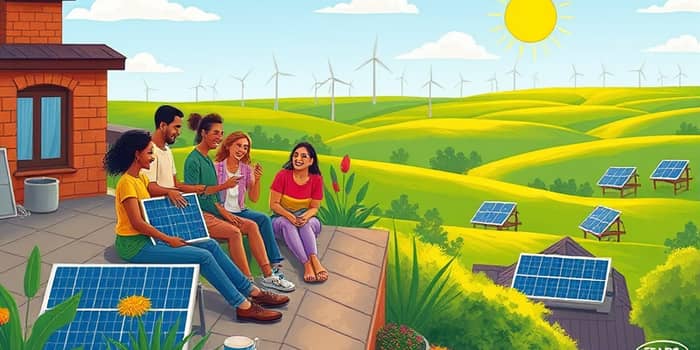Renters often feel trapped by the belief that sustainable energy is reserved for homeowners. Yet today’s innovations are rewriting that narrative, making renewable power accessible for every tenant.
Introduction: Renewables for Renters — The Growing Trend
More than one-third of American households are renters, and these tenants increasingly seek ways to align their homes with their values. With climate change concerns rising and energy bills climbing, renters are asking: “How can I tap into clean energy without owning my home?” This question has sparked a wave of creative, practical solutions.
Common Myths and Barriers
Historically, solar panels and renewable installs required rooftop ownership, long payback periods, and landlord buy-in—factors that appeared insurmountable for tenants. However, these obstacles are not permanent walls but challenges that can be overcome.
Key barriers include:
- Restrictions on making permanent modifications without approval.
- Misaligned lease terms versus long payback periods of solar.
- Landlords’ reluctance to navigate upfront costs or unfamiliar technology.
- Inability for renters to claim certain incentives directly.
Recognizing these hurdles is the first step toward dismantling them—and it turns out there are multiple pathways forward.
Practical Renewable Solutions for Renters
Modern renewables come in many forms, each offering unique benefits and requirements. Here are the top four options available to tenants.
- Community Solar Subscriptions: Join a local solar farm and earn bill credits proportional to your share. No installation on your property is needed, and about one-third of U.S. states now host active community solar programs.
- Utility Green Power Plans and RECs: Choose a “green” tariff from your utility or purchase renewable energy credits ensuring that your electricity use is matched by wind or solar generation elsewhere.
- Portable Solar Panels for Renters: Lightweight, easy-to-set-up panels for balconies or yards, plus solar generators and plug-in solar kits that offset part of your consumption.
- Collaborating with Your Landlord: Propose rooftop solar or efficiency upgrades, highlighting benefits like higher property value and reduced utility costs and leveraging the federal Solar Investment Tax Credit.
Each approach can be combined with other strategies to maximize impact and savings.
Comparing Renewable Options
Energy Efficiency Upgrades
Renewable energy is more effective when paired with efficiency measures. Renters can reduce consumption and boost savings with straightforward tweaks.
- Upgrade to LED lighting and smart thermostats to cut usage by up to 15%.
- Improve insulation around windows and doors with draft stoppers and weatherstripping.
- Choose eco-friendly appliances or adopt energy-saving habits like unplugging idle electronics.
These actions require minimal investment and can often be implemented unilaterally by tenants, immediately improving comfort and lowering bills.
Financial and Policy Considerations
Understanding the monetary landscape empowers renters to make informed decisions and negotiate effectively with landlords.
Federal incentives such as the Solar Investment Tax Credit still cover a significant portion of installation costs for property owners. State and local rebates may be available directly to renters for efficiency improvements.
Community solar programs often guarantee lower-than-standard rates in many states. Even when green power plans carry a small premium, the environmental benefit and potential bill stabilization can outweigh the cost.
Legal and Practical Tips for Tenants
Negotiation and clear communication are crucial. Here are steps renters can take:
- Open a dialogue about energy upgrades, presenting data on long-term cost savings and property value increases.
- Engage professional installers to reassure landlords about property integrity and safety.
- Leverage state community solar directories to showcase existing successful projects.
- Explore rent-for-service models where tenants share upfront costs in exchange for reduced rent or utility credits.
Success Stories and Case Studies
Across the U.S., renters moving into solar-equipped buildings report utility bills dropping by 20–50%, depending on local rates and solar generation. In one coastal community, a tenant-led effort convinced the landlord to install panels on a 30-unit building; residents now split the monthly savings.
Short-term rental hosts have also tapped into renewables, marketing their listings as eco-friendly getaways and commanding up to 15% higher nightly rates. These real-world examples prove that, with initiative and partnership, tenants can drive meaningful change.
Conclusion: The Future is Bright
Renters no longer need to feel powerless in the face of rising energy costs and climate concerns. From community solar subscriptions and renewable energy credits to portable solar solutions and landlord collaborations, there is a path for every tenant.
By combining renewable options with simple efficiency upgrades and leveraging available incentives, renters can enjoy cleaner energy, lower bills, and contribute positively to a sustainable future. The green revolution is not just for homeowners—it belongs to everyone, regardless of where they hang their keys.
References
- https://www.greenlancer.com/post/solar-energy-rental-home
- https://www.nyserda.ny.gov/Residents-and-Homeowners/Save-Energy-in-Your-Apartment
- https://www.solarreviews.com/blog/solar-panels-for-rental-homes-and-apartments
- https://www.rpmchoice.com/sustainable-practices-for-rental-properties
- https://www.igs.com/energy-resource-center/energy-101/renting-you-have-sustainable-energy-options-too
- https://www.investopedia.com/articles/personal-finance/061515/4-things-landlords-are-not-allowed-do.asp
- https://hosttools.com/blog/short-term-rental-tips/solar-panel-on-rental-property/










